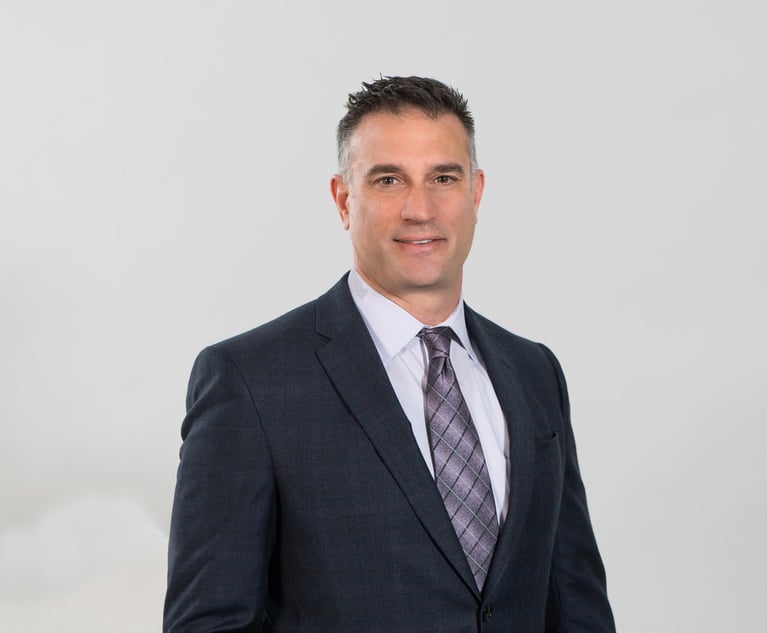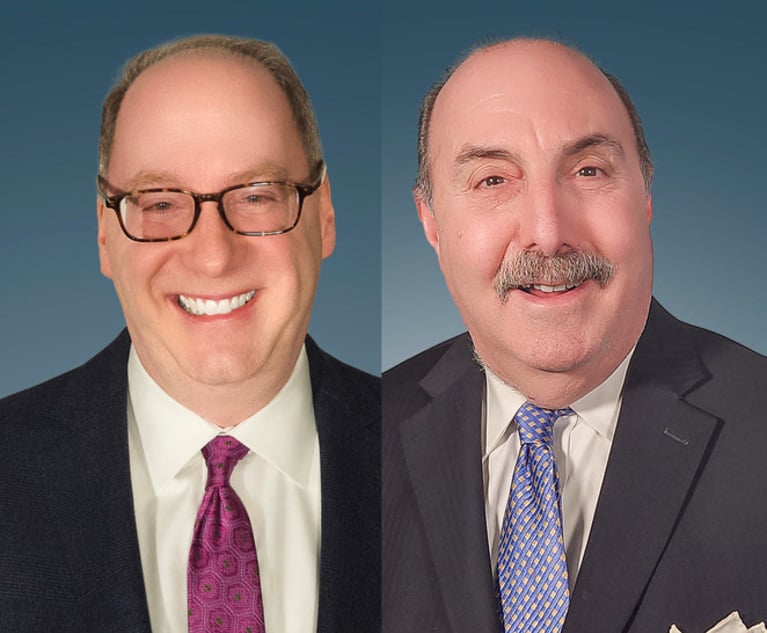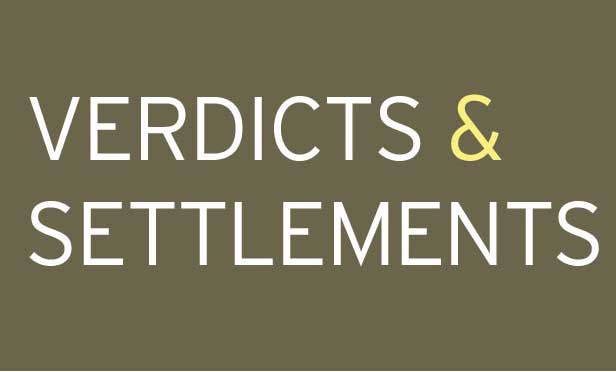Plaintiff Argued Driver Made Improper Turn in Front of Him
On May 30, 2015, plaintiff Harold Pena, a baker in his late 40s, was driving on Castor Avenue, in Northeast Philadelphia. When he was at the intersection with Passmore Avenue, his SUV rear-ended a sedan. He claimed neck injuries.
November 15, 2018 at 03:35 PM
4 minute read
Pena v. Dunaway
$12,500 Verdict
Date of Verdict: Aug. 16.
Court and Case No.: C.P. Philadelphia No. 160200476.
Judge: Lisette Shirdan-Harris.
Type of Action: Motor vehicle.
Injuries: Neck, back and knee injuries.
Plaintiffs Counsel: Sam Reznik, Simon & Simon, Philadelphia.
Plaintiff Expert: Maxwell Stepanuk Jr., orthopedic surgery.
Defense Counsel: Lynn A. Zikoski, Hubshman, Flood, Bullock & Dorn, Plymouth Meeting.
Defense Expert: Sachin Dheer, radiology, Cherry Hill, New Jersey.
Comment:
On May 30, 2015, plaintiff Harold Pena, a baker in his late 40s, was driving on Castor Avenue, in Northeast Philadelphia. When he was at the intersection with Passmore Avenue, his SUV rear-ended a sedan. He claimed neck injuries.
Pena sued the sedan's driver, Cheryl Dunaway, alleging that she was negligent.
During court-mandated arbitration, Pena was determined to receive $17,500. Dunaway rejected the award, and the case went to trial.
At trial, Pena testified that he had been driving on Castor Avenue when Dunaway, who had been stopped to his left on Passmore Avenue, turned left directly in front of him. Pena attempted to avoid the collision by swerving to his right, and the driver's side front of his vehicle struck the passenger's side rear of Dunaway's sedan. Pena's counsel faulted Dunaway for turning when it was unsafe to do so.
Dunaway testified that she had been stopped and inched forward to make sure there was a clear distance before turning. After doing so, she turned left and was struck by Pena. Dunaway's counsel maintained that Pena's failure to see Dunaway make the turn and respond appropriately suggested that he was not being attentive to road conditions.
Later that evening, Pena presented to an emergency room with complaints of pain to his neck, back, left knee and left, non-dominant arm. He was examined and released.
About a week later, Pena presented to a rehabilitation facility, where he treated with physical therapy through January 2017. Treatment included exercise and massage. After an MRI and an EMG, he was diagnosed with bulging at cervical intervertebral disc C4-5, bilateral radiculopathy stemming from C4-5, right-sided radiculopathy stemming from C5-6 and left-sided radiculopathy stemming from C6-7. It was determined that Pena had osteophytes at C5-6 and C6-7, which had allegedly been aggravated by the accident.
Pena consulted with an orthopedic surgeon. In January 2017, he had medial branch block injections at C4-5 and C5-6. No further treatment was rendered.
Pena's expert in orthopedic surgery causally related his injuries and treatment to the accident. The expert opined that he had suffered a serious impairment of a bodily function, and that he would require future treatment, including more physical therapy, pain injections and medical exams. Pena sought to recover $5,000 to $60,000 in future medical costs.
Pena testified that he has chronic pain in his neck, radicular pain in his arms and he has difficulty bending, twisting and standing and sitting for long periods. He sought damages for past and future pain and suffering.
Dunaway's counsel questioned the credibility of Pena's alleged injuries, since he had gone months without treatment.
The defense's expert in radiology testified that Pena's C4-5 bulging was pre-existing and unrelated to the accident. The expert noted that Pena's MRI showed degenerative pathology in his cervical spine, including osteophytes.
According to Pena, he had multiple gaps in his treatment because he found it difficult treating with physical therapy while working as a baker, from 3 a.m. to noon. He said that, despite his pain and discomfort, he did not miss a day from work because he had to his support his family. His wife was unemployed, one daughter was in college and his other daughter was entering college.
The jury found that Dunaway's negligence caused injury to Pena but that Pena did not suffer a serious impairment of a bodily function. Pena was determined to receive $12,500, all for future medical expenses.
This report is based on information that was provided by plaintiffs counsel. Defense counsel did not respond to the reporter's phone calls.
—This report first appeared in VerdictSearch, an ALM publication
This content has been archived. It is available through our partners, LexisNexis® and Bloomberg Law.
To view this content, please continue to their sites.
Not a Lexis Subscriber?
Subscribe Now
Not a Bloomberg Law Subscriber?
Subscribe Now
NOT FOR REPRINT
© 2025 ALM Global, LLC, All Rights Reserved. Request academic re-use from www.copyright.com. All other uses, submit a request to [email protected]. For more information visit Asset & Logo Licensing.
You Might Like
View All



Trending Stories
- 122-Count Indictment Is Just the Start of SCOTUSBlog Atty's Legal Problems, Experts Say
- 2Judge Rejects Walgreens' Contractual Dispute Against Founder's Family Member
- 3FTC Sues PepsiCo for Alleged Price Break to Big-Box Retailer, Incurs Holyoak's Wrath
- 4Greenberg Traurig Litigation Co-Chair Returning After Three Years as US Attorney
- 5DC Circuit Rejects Jan. 6 Defendants’ Claim That Pepper Spray Isn't Dangerous Weapon
Who Got The Work
J. Brugh Lower of Gibbons has entered an appearance for industrial equipment supplier Devco Corporation in a pending trademark infringement lawsuit. The suit, accusing the defendant of selling knock-off Graco products, was filed Dec. 18 in New Jersey District Court by Rivkin Radler on behalf of Graco Inc. and Graco Minnesota. The case, assigned to U.S. District Judge Zahid N. Quraishi, is 3:24-cv-11294, Graco Inc. et al v. Devco Corporation.
Who Got The Work
Rebecca Maller-Stein and Kent A. Yalowitz of Arnold & Porter Kaye Scholer have entered their appearances for Hanaco Venture Capital and its executives, Lior Prosor and David Frankel, in a pending securities lawsuit. The action, filed on Dec. 24 in New York Southern District Court by Zell, Aron & Co. on behalf of Goldeneye Advisors, accuses the defendants of negligently and fraudulently managing the plaintiff's $1 million investment. The case, assigned to U.S. District Judge Vernon S. Broderick, is 1:24-cv-09918, Goldeneye Advisors, LLC v. Hanaco Venture Capital, Ltd. et al.
Who Got The Work
Attorneys from A&O Shearman has stepped in as defense counsel for Toronto-Dominion Bank and other defendants in a pending securities class action. The suit, filed Dec. 11 in New York Southern District Court by Bleichmar Fonti & Auld, accuses the defendants of concealing the bank's 'pervasive' deficiencies in regards to its compliance with the Bank Secrecy Act and the quality of its anti-money laundering controls. The case, assigned to U.S. District Judge Arun Subramanian, is 1:24-cv-09445, Gonzalez v. The Toronto-Dominion Bank et al.
Who Got The Work
Crown Castle International, a Pennsylvania company providing shared communications infrastructure, has turned to Luke D. Wolf of Gordon Rees Scully Mansukhani to fend off a pending breach-of-contract lawsuit. The court action, filed Nov. 25 in Michigan Eastern District Court by Hooper Hathaway PC on behalf of The Town Residences LLC, accuses Crown Castle of failing to transfer approximately $30,000 in utility payments from T-Mobile in breach of a roof-top lease and assignment agreement. The case, assigned to U.S. District Judge Susan K. Declercq, is 2:24-cv-13131, The Town Residences LLC v. T-Mobile US, Inc. et al.
Who Got The Work
Wilfred P. Coronato and Daniel M. Schwartz of McCarter & English have stepped in as defense counsel to Electrolux Home Products Inc. in a pending product liability lawsuit. The court action, filed Nov. 26 in New York Eastern District Court by Poulos Lopiccolo PC and Nagel Rice LLP on behalf of David Stern, alleges that the defendant's refrigerators’ drawers and shelving repeatedly break and fall apart within months after purchase. The case, assigned to U.S. District Judge Joan M. Azrack, is 2:24-cv-08204, Stern v. Electrolux Home Products, Inc.
Featured Firms
Law Offices of Gary Martin Hays & Associates, P.C.
(470) 294-1674
Law Offices of Mark E. Salomone
(857) 444-6468
Smith & Hassler
(713) 739-1250






